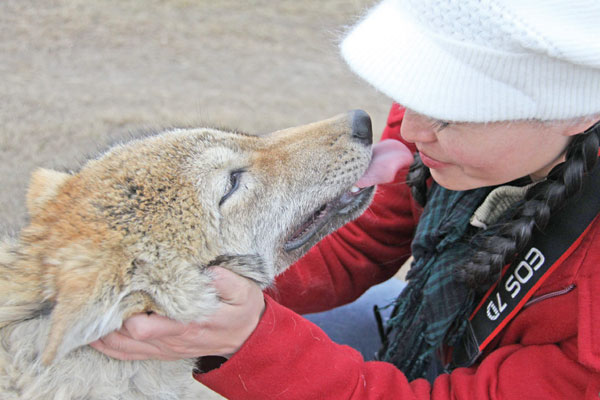Call of the wild
 |
|
A painting by Li Weiyi shows a slaughtered wolf with her cub by her side |
 |
|
Li Weiyi bids farewell to Green as she sets him free to the wild. |
Li tracked down the only surviving cub, which was then faking death for self-protection.
Afraid of being bitten, Li watched the cub from a distance and randomly uttered several howls of lament. The little wolf reacted and leaned into her embrace, and Li savored the connection.
Fighting a high fever, the cub was weak. Li decided to take him to the city for treatment and adopt him. She named him "Green", homophonic to the Grimm brothers, whose tales feature a lot of bad wolves.
"I hope my Green will rewrite the bad wolf tales," Li says. "Wolves are smart and dignified, and even humane."
 |
Li had saved many homeless dogs before she took in the wolf cub. But this was different.
"He bites ferociously, without regard for hurting the feeder," she says.
When the cub was a month old, Li started to take Green out for exercise. Green refused to be chained or be dragged by the chain.
"To protest, he once frayed his belly against the cement ground when I dragged him," she says.
She says the two later "agreed" on the chaining but only for pretence. Green would decide which way they would walk, and he'd take the lead.
To hide the wolf from her parents, Li moved Green to the house of her friend Yi Feng, who offered encouragement.
Li read a lot to gain knowledge on feeding Green; she even e-mailed international conservation organizations abroad for information.
Among the written resources, Wolf Totem has inspired her a great deal.
"When I first read the book years ago I thought that the writer was exaggerating on the wolves' special qualities. Then I saw he was telling real stories," Li says.
Li played the role of fellow cubs with Green, playing or competing with him. She got hurt frequently. She even tried to teach Green wolf howls by playing recordings and demonstrating.
Growing bigger, Green became a threat in city life. Though sad about separation, Li took Green back to the grassland where he was born in 2010 and made a plan.
 |
"I didn't want to deprive Green of the freedom he deserves," Li says.
Li took three steps, placing Green first among Tibetan Mastiffs, then into the wild and then into the wolf pack. All along, she acted with the wolf and trained him like a mother wolf.
To teach Green to hunt, Li huddled with Green in front of a rabbit hole for hours. In return for the love, Green greeted his "mother" every morning through the window, and left her with the stones he collected from the wild as gifts.
When Green was finally accepted by the leader of a wild wolf pack in February 2011, Li watched as his footprints disappeared in the distance on the snowy ground.
From a little cub, Green had grown into a wolf 90 cm tall from the head, and 100 cm long, not counting the tail. Li was reluctant to turn to the next page of her life, without Green. She returned to the grasslands several times afterwards to look for the wolf, but never saw him again. Now she wants people to understand the wolves' importance in the ecological chains. According to an incomplete survey, the number of wild wolves in the country is in the thousands.
Most important: She'd like to wipe away the common notion that wolves are evil.
"Wolves carry the essence of grassland spirits of respect, freedom and equality," says CCTV anchor Bai Yansong, an Inner Mongolian native, after reading Li's experience.
Li says months with Green turned her into a stronger woman.
"Even the young wolf can find ways to adapt and survive. How can I lose or show fear in front of my own battles?" she says.
Contact the writer at meijia@chinadaily.com.cn
















